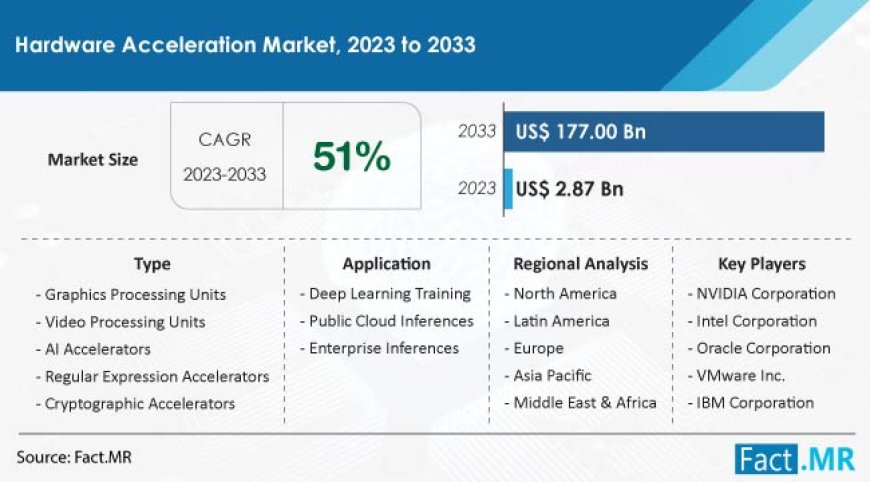Hardware Acceleration Market is Forecasted to Reach US$ 177 billion by 2033

According to a newly published research report by Fact.MR, a market research and competitive intelligence provider, the global hardware acceleration market is valued at US$ 2.87 billion in 2023. The worldwide demand for hardware acceleration is expected to grow at an impressive CAGR of 51% through 2033, driven by the increasing adoption of various data accelerators across a diverse range of enterprises.
Hardware acceleration offers numerous benefits, including lower latency, reduced power consumption, higher bandwidth, and parallel processing capabilities. The technology leverages functional components and areas within different integrated circuits. Key industries driving the demand for hardware acceleration include healthcare, energy, logistics, hospitality, retail, and BFSI.
Hardware acceleration is widely used for specific functions such as high-quality sound playback and recording, and efficient rendering of high-definition images compared to CPU-based software. It is designed for task-specific purposes, utilizing video processing chips or GPUs to handle complex arithmetic operations.
For More Insights into the Market, Request a Sample of this Report:
https://www.factmr.com/connectus/sample?flag=S&rep_id=8763
Key Takeaways from the Market Study:
- The global hardware acceleration market was valued at US$ 1.9 billion in 2022.
- Current market value stands at US$ 2.87 billion in 2023.
- The market is projected to grow rapidly at a CAGR of 51% from 2023 to 2033.
- Global sales of hardware acceleration are expected to reach US$ 177 billion by 2033.
- Demand for graphics processing units is anticipated to increase significantly.
Growing Demand for Hardware Acceleration Across Various Applications
The increasing use of hardware acceleration techniques in diverse computer systems, from high-performing PCs to low-power smartphones, is expected to drive market growth. The rising production and adoption of smartphones and personal computers, along with the growing need for hardware acceleration in video encoding and decoding, are projected to create lucrative opportunities for market players. Additionally, the expanding application of hardware acceleration tools in machine learning and deep learning is anticipated to propel the market over the next decade.
Various industries are seeking a wide range of graphics processing units (GPUs) to enhance their operational efficiency. These factors are likely to accelerate market expansion opportunities.
Rising Use of Cloud Computing Technology Boosting Demand for Hardware Acceleration in the United States
The United States is expected to contribute significantly to North American market revenue. The increasing adoption of cloud computing technology by various firms in the U.S. is projected to create opportunities for market players.
Challenges Impacting Hardware Acceleration Demand
Despite its advantages, hardware acceleration faces challenges that may hinder market growth. The inability to support current 2D drawing operations is anticipated to limit market expansion over the next decade. Additionally, the high costs associated with implementing and maintaining hardware acceleration are also restraining its demand.
Get Customization on this Report for Specific Research Solutions:
https://www.factmr.com/connectus/sample?flag=RC&rep_id=8763
Segment Analysis
The study divulges essential insights into the market based on product (graphics processing units, video processing units, AI (artificial intelligence) accelerators, regular expression accelerators, cryptographic accelerators) and application (deep learning training, public cloud inferences, and enterprise inference), across five major regions of the world (North America, Europe, Asia Pacific, Latin America, and MEA).
Competitive Analysis
Market participants working in the hardware acceleration environment execute a number of similar measures, such as strengthening supply chain management systems, maintaining product standards, and quality control. Key players are expected to benefit from these initiatives as they expand their worldwide footprints and add value to their current portfolios.
Key Market Players
NVIDIA Corporation, Advanced Micro Devices Inc., Intel Corporation, Achronix Semiconductor, Xilinx Inc., Oracle Corporation, IBM Corporation, Lenovo Group Limited, Hewlett Packard Enterprise Company Dell, Fujitsu Ltd., VMware Inc., Cisco Systems Inc., Enyx, AlphaLab Gear, Wazer, HWTrek, Teradici, HAX, Revvx

 swatichaudhari
swatichaudhari 










